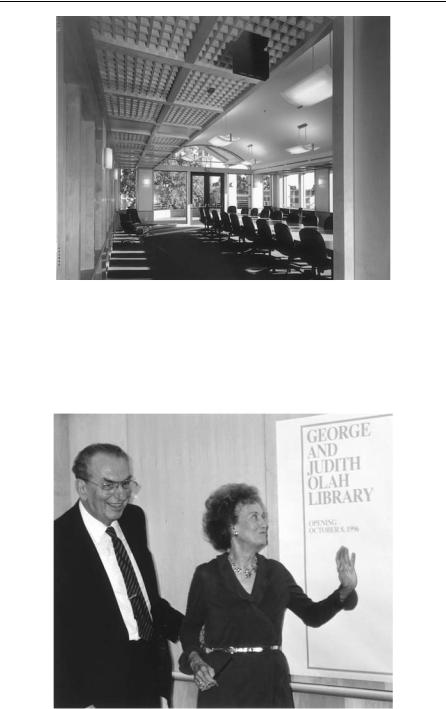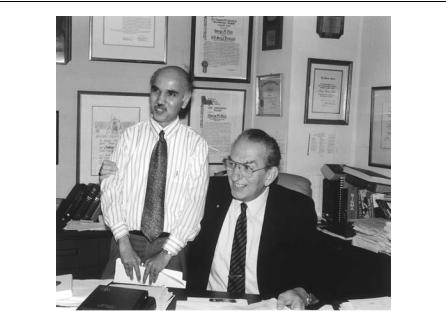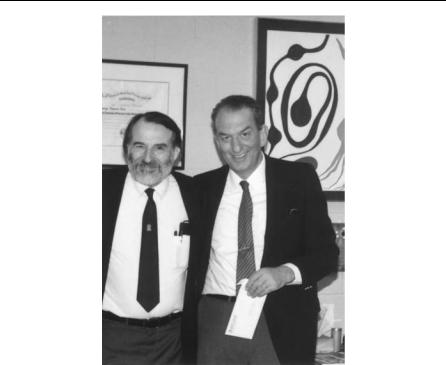
Olah G.A. - A Life of Magic Chemistry (2001)(en)
.pdf
120 A L I F E O F M A G I C C H E M I S T R Y
The extended Institute now has some 43,000 sq. ft. of space in a most attractive setting and provides not only first-class research facilities but in a sense a home away from home for all in the Loker Institute family, including what the younger generation named ‘‘le bistro,’’ a pleasant setting for lunch and informal discussions.
The new addition of the building was completed by the end of 1994 and dedicated in February 1995. Because I coincidentally won the Nobel Prize just two months before (more about this in Chapter 11), some believed that there was some relationship between the two events. This certainly was not the case. Katherine Loker and our other friends had made their wonderful gifts well before, and it was just a fortunate coincidence that we had such ‘‘good timing’’ to celebrate the opening of our enlarged institute.
Physical facilities help, but do not per se make a research institute. It is the people who work there and their contributions and devoted hard work that is most important. We are nearing a quarter of a century since the Hydrocarbon Research Institute was started at USC. At the beginning in 1977, Sid Benson and I shared the scientific directorship of the Institute and Jerry Segal carried out the administrative responsibilities as executive director. When we moved into our own building in 1979, Bill Stephenson, a physical-organic chemist and a former colleague of mine in Cleveland who subsequently joined us at
Katherine Loker wing of the Institute

M O V I N G T O L O S A N G E L E S 121
The Olah Library
Dedication of the Olah Library with Katherine Loker in 1996

122 A L I F E O F M A G I C C H E M I S T R Y
With Judy at the Library Dedication, 1996
USC, took over as executive director. Bill, a fine scientist and teacher, was also an outstanding colleague and good administrator. In 1983, however, he decided to pursue other interests and left academia.
To fill the void, we attracted another USC colleague John Aklonis, a polymer physicochemist, as executive director. With John joining the Institute, we made a commitment to include polymer chemistry and, subsequently, materials research as an integral effort. John became a close friend and is one of the nicest individuals I have ever met. He contributed greatly to our efforts and also helped me personally to continue to stay active in my research by taking most of the burden of administrative duties off me. His outgoing personality and humanity made him loved and respected by everyone and allowed the Loker Institute to continue and expand its work. John should be given the lion’s share of credit for making the expansion of our Institute a reality,

M O V I N G T O L O S A N G E L E S 123
helping to raise funds, planning the addition to our building, and keeping the Institute afloat in the sometimes turbulent waters of the internal politics of the university. John and his wife Jo were always avid sailors. Their life was very much centered around their sailing, and they even lived on their boat. In 1990 John, approaching the age of 50, decided to give up his university career, take early retirement, and set sail to spend the next decade (or two) on the high seas. Ten years later, after having sailed halfway around the world, they still are at it in the Far East, but I guess some day they will come back to the United States. We miss them very much, but we keep in touch and they fly back to visit LA occasionally. We wish them continued enjoyment, satisfaction, and safe sailing. From the Institute’s and my own point of view, however, John’s departure was a serious blow, and he was not easily replaced. Somewhat reluctantly, I took on the overall duties as director. Bill Weber and Robert Aniszfeld, who was a graduate student of mine, became our excellent associate directors, and together with our small but highly dedicated and efficient staff they take care of most administrative duties.
In shaping the scientific work of the Loker Institute as well as pursuing my own research interests, I got invaluable help from the colleagues who joined in the effort, and particularly from G. K. Surya Prakash, my former graduate student who stayed on. Over the years he became a highly respected professor, my partner in our joint research, and a close friend. It is not often that outstanding scientific ability and wonderful human characteristics are combined in a person. Prakash is such a unique person. I am lucky to have been associated with him for a quarter of century. I am also proud to have seen him develop into an outstanding scholar and teacher in his own right. He moved up in his academic career to a professorship, and when Judy and I donated part of my Nobel money to establish, together with the generous help of Carl Franklin and other friends, a professorship at USC, to my delight, Prakash was named the first ‘‘George and Judy Olah Professor.’’ He is now also scientific codirector of the Loker Institute and doing a great job. Other faculty colleagues in our Institute include in the organic/polymer area Bill Weber, Thieo Hogen-Esch, Nicos Petasis, and more recently Roy Periana and Aaron Harper. Golam

124 A L I F E O F M A G I C C H E M I S T R Y
With Surya Prakash
Rasul, a research faculty member, contributes significantly to our computational chemistry efforts. Bob Williams continues his fascinating probing of boron compounds. Karl Christe, an outstanding inorganic chemist and an adjunct professor, heads an extremely productive laboratory in the chemistry of fluorine compounds and high-energy compounds. Bob Bau provides all of us with great help in x-ray crystallography. After Sid Benson’s retirement, Larry Dalton (also a scientific co-director) Jim Haw and Marc Thompson have spearheaded efforts in the more physically oriented materials-catalysis area.
Since its inception, the institute, in addition to its regular faculty members, has always had a number of outstanding scientists associated with it as fellows or adjunct faculty. These include, among others, Ned Arnett, Joe Casanova, Paul Schleyer, Jean Sommer, Gabor Somorjai, Peter Stang, Michael Szwarc (who just recently passed away), Ken Wade, and Bob Williams. They greatly contribute to our scientific work by their visits and participation in our symposia and frequently through close research cooperation. Because they are also close friends,

M O V I N G T O L O S A N G E L E S 125
With Paul Schleyer
our association adds much to the enjoyment and pleasure of our efforts. I only hope that they also feel the same in some way.
The objectives of the Loker Hydrocarbon Research Institute have stayed the same since its inception in 1977. They are:
To pursue the long-range development of hydrocarbon chemistry
To develop new fuels and materials and to provide environmentally sustainable solutions to energy generation problems
To train researchers in the field of hydrocarbon chemistry
To further the interchange of information through publications and symposia on developments in hydrocarbon chemistry
To act as an international center of hydrocarbon chemistry and to facilitate exchange of information and ideas through visits of scientists, colloquia, and research symposia

126 A L I F E O F M A G I C C H E M I S T R Y
With Peter Stang
To foster a close relationship with the chemical, petroleum, gas, and energy industries and governmental agencies for the exchange of information and knowledge and to ensure that research results and discoveries of significance will be effectively exploited
Hydrocarbons, as their name indicates, are compounds of carbon and hydrogen. They represent one of the most significant classes of organic compounds. The scope of hydrocarbons is broad. They include saturated hydrocarbons (alkanes, cycloalkanes) and their derivatives as well as unsaturated alkenes and dienes, acetylenes, and aromatics. In methane (CH4), the simplest saturated alkane, a single carbon atom is bonded to four hydrogen atoms by sharing electron pairs, i.e., by covalent bonds. In the higher homologues of methane (of the general formula CnH2n 2), all atoms are bound to each other by such single [sigma ( ), two electron-two center] bonds, with carbon atoms also displaying their ability bind to each other to form C-C bonds. Carbon atoms can be aligned in open chains (acyclic hydrocarbons). Whereas in CH4 the H : C ratio is 4, in C2H6 (ethane) it is decreased to 3, in C3H8 (propane) to 2.67, and so on. Alkanes can be straight-chain (each

M O V I N G T O L O S A N G E L E S 127
carbon attached to 2 other carbon atoms) or branched (in which at least 1 carbon is attached to either 3 or 4 other carbon atoms).
Carbon can also form multiple bonds with other carbon atoms. This results in unsaturated hydrocarbons such as olefins (alkenes), containing a carbon-carbon double bond, or acetylenes (alkynes), containing a carbon-carbon triple bond. Dienes and polyenes contain two or more unsaturated bonds.
Carbon atoms can also form cyclic compounds. Aromatic hydrocarbons (arenes), of which benzene is the parent, consist of a cyclic arrangement of formally unsaturated carbons, which, however, give a stabilized (in contrast to their hypothetical cyclopolyenes), delocalized system.
The H : C ratio in hydrocarbons is indicative of the hydrogen deficiency of the system. As mentioned, the highest theoretical H : C ratio possible for hydrocarbon is 4 (in CH4), although in electron-deficient carbocationic compounds such as CH5 and even CH62 , the ratio is further increased (to 5 and 6, respectively, see Chapter 10). On the other end of the scale in extreme cases, such as the dihydroor methylene derivatives of recently discovered C60 and C70 fullerenes, the H : C ratio can be as low as 0.03.
Hydrocarbons are abundant in nature. All fossil fuels (coal, oil, gas) are basically hydrocarbons, deviating, however, significantly in their H : C ratio.
H:C ratio of natural hydrocarbon sources
Methane |
4.0 |
Natural Gas |
3.8 |
Petroleum crude |
1.8 |
Tar sands bitumen |
1.5 |
Shale oil (raw) |
1.5 |
Bituminous coal |
0.8 |
|
|
Natural gas, depending on its source, contains—besides methane as the main hydrocarbon compound (present usually at >80–90%)— some of the higher homologous alkanes (ethane, propane, butane). In ‘‘wet’’ gases the amount of C2-C5 alkanes is higher (gas liquids).

128 A L I F E O F M A G I C C H E M I S T R Y
Petroleum or crude oil is a complex mixture of many hydrocarbons. It consists of saturated, predominantly straight-chain alkanes, small amounts of slightly branched alkanes, cycloalkanes, and aromatics. Petroleum is generally believed to be derived from organic matter deposited in the sediments and sedimentary rocks on the floor of marine basins. The identification of biological markers such as petroporphyrins provides convincing evidence for the biological origin of oil (however, there may also be hydrocarbons of abiogenic origin). The effects of time, temperature, and pressure in the geological transformation of the organics to petroleum are not yet clear. However, considering the low level of oxidized hydrocarbons and the presence of porphyrins, it can be surmised that the organics were acted upon by anaerobic microorganisms and that temperatures were moderate, <200 C. By comparing the elemental composition of typical crude oils with typical bituminous coals, it becomes clear why crude oil is a much more suitable fuel source in terms of its higher H : C atomic ratio, generally lower sulfur and nitrogen contents, very low ash contents (probably mostly attributable to suspended mineral matter and vanadium and nickel associated with porphyrins), and essentially no water content.
It is interesting to note that recent evidence shows that even extraterrestrially formed hydrocarbons can reach the Earth. The Earth continues to receive some 40,000 tons of interplanetary dust every year. Mass-spectrometric analysis has revealed the presence of hydrocarbons attached to these dust particles, including polycyclic aromatics such as phenanthrene, chrysene, pyrene, benzopyrene, and pentacene of extraterrestrial origin indicated by anomalous isotopic ratios.
Petroleum—a natural mineral oil—was referred to as early as the Old Testament. The word petroleum means ‘‘rock oil’’ [from the Greek petros (rock) and elaion (oil)]. It has been found for centuries seeping out of the ground, for example, in the Los Angeles basin in what are now called the La Brea tar pits. Vast deposits were found in Europe, Asia, the Americas, and Africa.
In the United States, the first commercial petroleum deposit was discovered in 1859 near Titusville in western Pennsylvania when Edwin Drake and Bill Smith struck oil in their first shallow ( 20 m) well. The well yielded some 400 gallons of oil per day (about 10 barrels).

M O V I N G T O L O S A N G E L E S 129
The area had already been known to contain petroleum, which residents skimmed from the surface of a local creek, called ‘‘Oil Creek.’’ The first oil-producing well rapidly opened up a whole new industry. The discovery was not unexpected, but it provided evidence for oil deposits in the ground that could be reached by drilling. Oil was used for many purposes at that time, such as burning in lamps and even medical remedies. The newly discovered Pennsylvania petroleum was soon also marketed to degrease wool, prepare paints, fuel steam engines, power light railroad cars, and for many other uses. It was recognized that the oil was highly impure and had to be refined to separate different fractions for varied uses. The first petroleum refinery, a small stilling operation, was established in Titusville in 1860 and subsequently John D. Rockefeller started his Standard Oil empire with a refinery in his hometown of Cleveland. Petroleum refining was much cheaper than producing coal oil (kerosene), and soon petroleum became the predominant source for kerosene as an illuminant. With the popularity of automobiles in the 1910s, gasoline became the major petroleum product. Large petroleum deposits were found in California, Texas, Oklahoma, and, more recently, Alaska. Areas of the Middle East, Asia, Russia, Africa, South America, and, more recently, the North Sea became major world oil production centers.
The daily consumption of crude oil in the United States is about 18– 20 million barrels. The world consumption is about 75–80 million barrels (some 10–12 million tons) per day; the United States uses about 18–20% of the world’s total but has less than 5% of the world population. Most of this oil is used for the generation of electricity, for heating, and as transportation fuel. About 4% of the petroleum and natural gas is used as feedstocks for the manufacturing of chemicals, pharmaceuticals, plastics, elastomers, paints, and a host of other products. Petrochemicals from hydrocarbons provide many of the necessities of modern life, to which we have become so accustomed that we do not even notice our increasing dependence, even though the consumption of petrochemicals is still growing at an annual rate of 10%. Advances in the petroleum-hydrocarbon industry, more than anything else, may be credited for the high standard of living we enjoyed in the late twentieth century.
